By Alan M. Petrillo
Aircraft rescue and firefighting (ARFF) vehicle manufacturers have made great strides in ARFF vehicle design and operation in an effort to give firefighters greater fire knockdown power, more nimble vehicles that are more ergonomically friendly to operators, and rigs that require fewer personnel to operate them.
Changing Designs
Marty Huffman, Rosenbauer’s ARFF regional manager, says Rosenbauer has made substantial improvements and modifications to its signature Panther ARFF truck, which is made in 4×4, 6×6, and 8×8 versions. “While the basic structure of the Panther has remained the same, we have made improvements in the cab and its layout, instrumentation, and control systems like our Logic control system that can be used to integrate chassis and pump controls into one easy-to-use box,” Huffman says.
The Panther models use Rosenbauer’s R600 1,850-gallon-per-minute (gpm) pump, which has a stainless steel pump shaft borne by triple roller bearings where the main bearings run in an oil bath in the gear box to make them maintenance-free. The Panther also uses the RVMA500 mechanical, automatic around-the-pump foam proportioning system and is available with three different turret configurations.
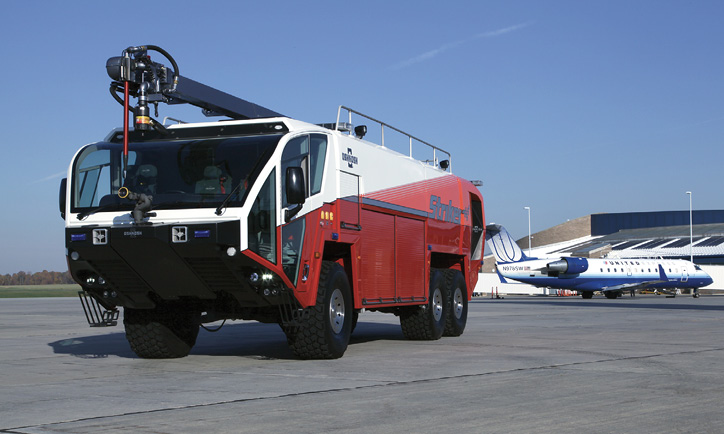
1 Oshkosh’s latest ARFF product is the Striker, which has an electronic foam proportioning system and is available with a Snozzle 501 HRET with a piercing nozzle. (Photo courtesy of Oshkosh.)
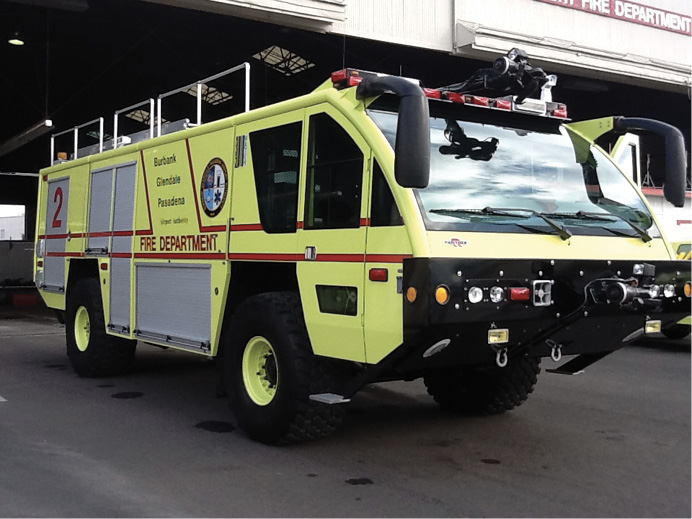
2 The Burbank-Glendale-Pasadena (CA) Airport Authority purchased this Rosenbauer Panther 4×4 ARFF truck that carries a 1,500-gallon water tank and is set up to run a CAFS that uses stored air cylinders instead of an air compressor. (Photo courtesy of Burbank-Glendale-Pasadena Airport Authority.)
Steve Schwartz, director of customer support for Oshkosh, says his company completed a redesign of its Striker ARFF unit in 2001 to meet both high-pressure water discharge and ultra-high-pressure (UHP) water discharge requirements, as well as to support stored air compressed air foam systems (CAFS).
Adam Graves, ARFF product manager for KME, says his company has redesigned and reengineered its Legacy ARFF product “going back to our own design of an aluminum cab and body. There also are internal changes to the vehicle where we’ve updated it, so it can be modern and still be tough.” Graves notes the aluminum cab and body make the vehicle lighter and more maneuverable.
Compressed Air Foam
CAFS are finding uses on ARFF vehicles, Huffman says. Rosenbauer has built ARFF units for the Ottawa International Airport that have compressed air foam available through their turrets. “It’s FlashCAFS technology—a stored energy system and not your typical CAFS compressor on a vehicle,” Huffman points out. “You have stored air bottles that are able to make three percent or six percent compressed air foam with a certain number of gallons of water.”
Rosenbauer also built a Panther 4×4 ARFF truck for Burbank-Glendale-Pasadena (CA) Airport Authority, according to Marc Domingo, a fire captain with the Airport Authority. “We were the first department to put CAFS on an ARFF truck for an Index C airport in California,” Domingo says. “We have it on our 2012 Panther with a 1,500-gallon water tank where it’s connected to a 150-foot handline discharge.”
Domingo says the truck doesn’t carry an air compressor but uses a stored air system where four large 2,500-pound-per-square-inch air cylinders hold enough compressed air to run the CAFS. “That way we don’t rob power from the truck,” Domingo points out. “We’ve used it extensively in training but not in an actual aircraft situation yet.”
Domingo notes that although the department usually gets a couple of minutes of compressed air foam out of the system, it’s not an endless supply of foam like what would be available with an air compressor. “If it were an exterior fire, we’d use the CAFS first because you use less water and foam and the CAFS has a long draindown time,” he says. “Then we’d switch back to using water and foam.”
Draindown is the amount of time a foam blanket stays intact on the structure the firefighter is trying to protect, Domingo says. CAFS also creates more bubbles, which have more surface area for heat absorption and cooling for greater suppression effect, he adds.
R.J. Jones, sales and product manager for United States government and airport products at E-ONE, believes the market will see more use of CAFS on ARFF vehicles in the near future. “Right now CAFS is approved for Class 1, 2, and 3 vehicles, with a Class 1 being a Ford F-550 chassis and a Class 3 being a Freightliner or International chassis,” Jones says. “I think the Federal Aviation Administration (FAA) will make it a selectable option in the near future for Class 4 trucks (4×4 models carrying 1,500 gallons of water) and Class 5 vehicles (6×6 and 8×8 with 3,000 gallons of water).”
Foam Systems
“The new Striker has our electronic foam proportioning (EFP) system that allows the operator to control foam flows accurately based on discharge water volume, whether flowing foam at one percent for training or three, six, or eight percent for live situations,” says Schwartz.
“Electronic foam proportioning works well with film forming fluoroprotein (FFFP), aqueous film forming (AFFF), and other foams that are new to the market, as well as with synthetics and ecofriendly products like Solberg and Ekopol,” Schwartz says. “The system automatically proportions the foam to the amount of water you’re flowing.”
E-ONE’s Eco-Logic Foam system has been approved for foam testing to NFPA 412, Standard for Evaluating Aircraft Rescue and Fire-Fighting Foam Equipment, Jones notes. “It’s a system integrated with the ARFF vehicle that allows testing of the foam system without having to discharge any foam,” he says. “We can turn the foam system off, then run water and a dye through the system to simulate flowing foam and determine how it performs. It gives the customer the ability to test the foam system more than only once a year and saves the cost of discharging foam during a test. The cost of the system is about the same as one load of foam.”
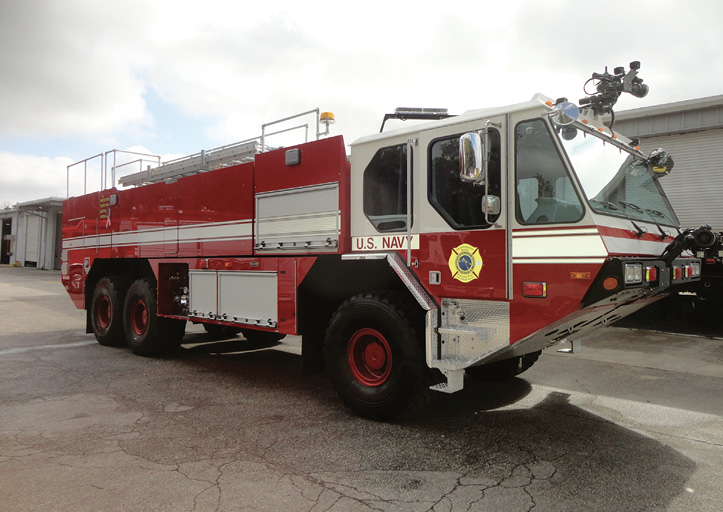
3 E-ONE built this Titan Force 6×6 ARFF rig for the United States Navy with a Zico electric ladder rack on top of the right side of the vehicle. (Photo courtesy of E-ONE.)
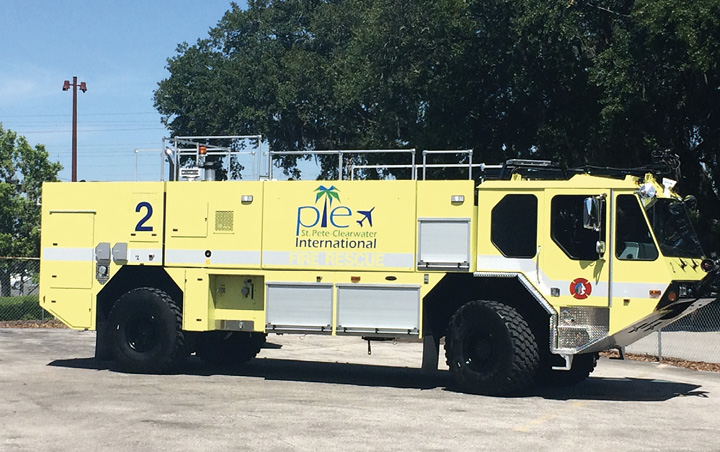
4 St. Pete-Clearwater International Airport turned to E-ONE to build this 4×4 Titan Force ARFF unit. (Photo courtesy of E-ONE.)
E-ONE also has a cart-based Eco-Logic Foam system that operates the same as the integrated system, Jones points out, where departments can have one cart per location so every ARFF vehicle wouldn’t have to be modified for testing.
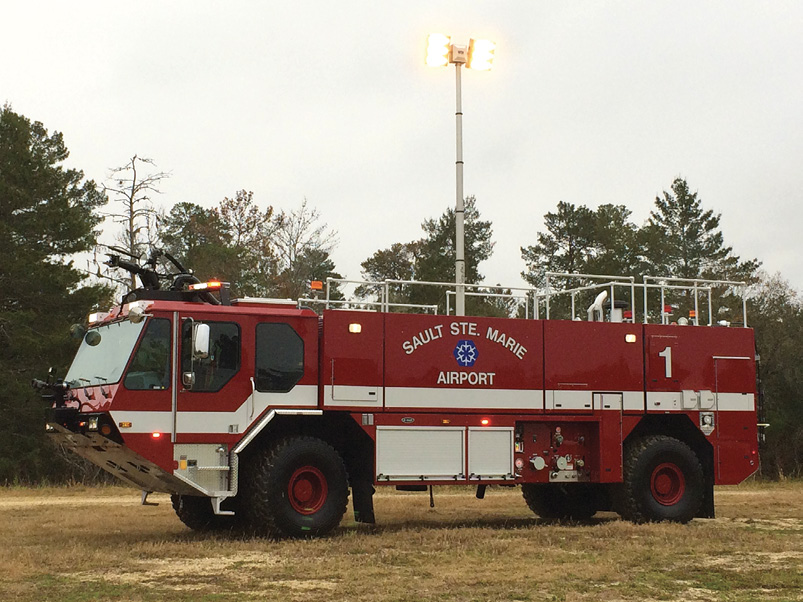
5 Sault St. Marie Airport in Ontario, Canada, had E-ONE incorporate a light tower into its Titan Force 4×4 ARFF truck. (Photo courtesy of E-ONE.)
A lot of ARFF customers are asking for Zico electric or hydraulic ladder racks on their trucks and foam transfer pumps, all in the interest of firefighter safety, Jones observes. “We’ve integrated a foam transfer pump behind the pump panel,” he notes. “The pumps range from 15 to 25 gpm. You take a 10-foot hose with a wand and stick it into your foam supply or foam bucket and there’s no need to carry anything to the top of the vehicle.”
Agent Delivery
Another feature introduced on Rosenbauer ARFF vehicles is the Stinger high reach extendable turret (HRET), Huffman notes. “The Stinger has a single multifunction joystick for boom, pierce, and nozzle control,” he says. “It features Rosenbauer’s Position and Shoot Technology (PASS) with penetration capabilities regardless of the piercing nozzle’s position and angle of attack to the fuselage and has a specially designed flared penetrating tip to cleanly pierce the composite material used on newer aircraft.”
Schwartz notes that Oshkosh has devoted a lot of attention to its Snozzle HRET, which it purchased from Crash-Rescue several years ago. “The Snozzle and our turrets can be integrated through the truck’s CANBUS system to a command zone,” he says. “The system ties into modules for the chassis and firefighting systems throughout the truck so common information can be displayed on the cab’s onboard screen.”
Typically, an ARFF vehicle will carry primary and secondary turrets—a high turret or an HRET on the roof and a bumper turret at the front, Schwartz says. “The primary is usually a high-flow turret, which on a 4×4 will be 750 gpm, and goes up to 1,250 gpm and 1,585 gpm, depending on the department’s needs,” he notes. “The primary can flow three kinds of agent—water, foam, or dry chemical—while the secondary usually only flows water and foam. But, those combinations can be designed how the department wants them.”
Oshkosh’s 4×4 Striker typically carries 1,500 gallons of water, while its 6×6 models carry 3,000 gallons. “We offer crosslays as an option and can put dual agents on handlines on either fixed or swing-out reels,” Schwartz says. “And with our bumper turret, we offer a low attack option where the turret can be dropped to the ground to give a low discharge approach, which is popular to fight fuel fires and for getting underneath an aircraft’s wings.”
Oshkosh also has designed its vehicle’s rear engine space so it is easy to get to and maintain by having walk-in service compartments on both sides of the engine. The company also increased storage compartment heights by making the compartments taller with roll-up doors.
KME’s new vehicle, the Force, has a totally new pumping system, Graves says. “It has two Waterous pumps, a standard pump and a UHP pump. The standard pump can supply all discharges, while the UHP supplies the bumper turret and two hand reels of 200 feet of 1¾-inch hose each.”
KME’s Class 4 Force is on a 4×4 chassis; carries 1,500 gallons of water, 200 gallons of foam, and a 500-pound dry chemical or Halotron system; and has a variety of roof and bumper turret options. The Class 5 Force is a custom 6×6 or 8×8 chassis that can carry from 3,000 to 4,500 gallons of water and 400 to 600 gallons of foam, has options for dry chemical or Halotron systems, and offers a variety of turrets.
Emissions Controls
Jones notes that its ARFF trucks business has been “pretty steady where we have a good share of the FAA market,” and that international business remains consistent. One of the changes coming up for ARFF vehicles goes into effect in 2017. ARFF trucks will have to use the same emissions controls that over-the-road and firefighting vehicles have been using as a result of 2010 and 2013 diesel engine emissions requirements. “It will impact the ARFF world and everyone is gearing up for that,” Jones points out.
Jones says E-ONE is looking into the changes to the drive train and other systems it will have to make. “We’re evaluating that now with the timing and may bring to market a new model ARFF vehicle,” he says.
ALAN M. PETRILLO is a Tucson, Arizona-based journalist and is a member of the Fire Apparatus & Emergency Equipment editorial advisory board. He served 22 years with the Verdoy (NY) Fire Department, including in the position of chief.

